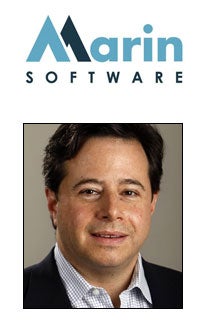 Chris Lien is CEO of Marin Software, makers of a paid search management application.
Chris Lien is CEO of Marin Software, makers of a paid search management application.
AdExchanger.com: How do you respond to some who say that the world of SEM management has been commoditized? How does Marin Software differentiate?
The only way the paid search management tools market will become commoditized is if paid search were to suddenly become less complex. So far that hasn’t happened, and we don’t see this happening. At Marin, we are seeing increasing complexity for advertisers and agencies as they deal with new aspects of paid search, e.g., mobile, local, rich media, etc. In addition, there is a desire to integrate paid search with multiple systems throughout the enterprise, perform custom reporting and analysis, and optimize to unique business goals. So, we don’t see commoditization at all. One of Marin’s advantages is its ability to meet advertisers where they are, adapting to their current business environment and practices rather than forcing them to use a cookie cutter solution. So far that approach has served us well with large advertisers and agencies worldwide.
In general, do you see search engine marketing and display advertising services beginning to merge? Why or why not?
As marketers look to have more accountable or performance-based media, there is definitely some pressure to merge display with search. As of now, this is a small but growing portion of the display world. Paid search is a very large and efficient market, with all ad inventory addressable via an API. In contrast, the majority of the display inventory in the world is still being bought with paper-based insertion orders. As display inventory shifts to more manageable channels such as API-enabled networks and exchanges, the opportunity for search and display services to merge increases. I don’t think we’ve crossed the tipping point in terms of volume for that to happen as of yet.
Yahoo!’s Ramsey McGrory announced at Right Media Open that you and several other SEMs will begin working with Right Media Exchange. How? Do you consider Marin a demand-side platform?
The starting point here for us is really around attribution. Paid search sits at the bottom of the funnel today. As a result, in order to “value” display inventory correctly, you need to be able to measure how many downstream searches and search conversions a display ad influenced. Marin is enabling that tracking for many of its customers today. Over time, you’ll see Marin leverage what Right Media offers to more closely link display buying enabled by Right Media with the social media and search functionality of Marin.
Beyond the RMX affiliation, what is Marin doing about display today? Any more plans for tomorrow?
From a pure display perspective, Marin offers the ability to view path-to-conversion or channel analysis in our platform. We enable advertisers and agencies to upload their display ad metrics into Marin so that they can be viewed alongside search and social channels. We have deep integrations with DART and Atlas to enable Marin to leverage the existing display tracking infrastructure for reporting and analytics within the Marin platform. In addition to these display capabilities within Marin, we recently announced support for Facebook, which has more similarities to paid search than it does to display. With our solution, advertisers get deeper insight into audience performance at a very granular level. This transparency helps marketers to first find the right audiences on Facebook, and then provides them with the tools to optimize for those audiences efficiently.
Looking at SEM, what recent innovations has Marin brought to its search engine marketing management software that you see as critical going forward?
One of the more powerful innovations we have delivered to market is the ability to generate dynamic campaigns using structured data feeds. This allows long tail advertisers with large product sets to automate the process of advertising their entire catalog. The beauty of the solution is that it not only helps advertisers expand their reach, but it also helps them improve the quality of campaigns by dynamically associating relevant product information with ad copy. We also can leverage these data feeds to enable inventory-based bidding so that you are only advertising what you have available to sell based on predefined business rules. Another Marin innovation is in the area of Quality Score management whereby Marin has tools within its platform to enable the search marketer to improve the Quality Score of the underlying search campaigns. Most search marketers forget that financial performance is approximately half bid-based and half Quality Score-based. Everyone is very focused on bidding properly – and Marin’s customers derive tremendous value from our advanced bidding. But, we also remind our customers to focus equally on Quality Score, e.g., matching keyword conversion rates into tighter ad groups, as this can lead to equally beneficial financial gains. A related area of innovation is in keyword management – both in keyword creation and in suggestion of keyword negatives. By refining the keyword universe, including negatives and match types, a search marketer can further improve financial performance. Marin has automated, transparent functionality to execute these tasks.
What trends can you share that you are seeing from your clients today?
One trend we see is increasing CPCs across clients. This is a challenge for agencies and advertisers as they attempt to scale programs while maintaining a consistent cost of acquisition. As a result of this trend, we see advertisers increasingly turning to campaign-driven tactics for improving ROI. This includes a combination of smart management of match types and negatives, structuring ad groups to improve quality scores, and testing creative to maximize conversion. When done right, we have seen marketers able to offset increasing CPCs through campaign quality, and often times manage to scale their programs while lowering costs.
Have you seen any benefits yet from Google approving Marin for preferred AdWords API pricing?
I think the real winner here is our customers. We’ve seen clients begin to rethink how they use our tool now that API fees have been lifted, especially advertisers with large keyword sets. Many of our largest advertisers would suppress small bid changes in an effort to avoid API charges. Now that fees are gone they are free to tune bids more finely, adjusting them to even the slightest day of week fluctuation in user behavior.
How relevant to the overall search engine marketing mix is Yahoo and Microsoft today? Do you see clients ignoring both and just running with Google? If so, why do you think that is?
The vast majority of our clients already advertise across Google, Yahoo!, and Bing. In fact, the very nature of our platform enables this through more efficient cross publisher reporting and management. With the transition to the Yahoo-Bing Search Alliance, I think we are likely to see these two engines become a lot more relevant. The main reason for this is the efficiencies that marketers will realize. With the ability to access the combined inventory through a single platform, the Search Alliance will receive as much attention as before, only it will be focused on one program as opposed to two. That’s a lot of time saved for reinvestment in optimization and expansion. We’re bullish on the Search Alliance and are impressed by the detailed planning being done by Yahoo! and Bing.
What will be the impact of Facebook’s display ads on search engine marketing over the next year? How is Marin responding?
We see Facebook as a companion media channel to paid search. Facebook’s impact on advertising will be large in our view. The sheer size of the audience dictates that ad dollars will shift to the platform, but no one knows if this will be funded from offline or on-line budget shifts. A big opportunity here, is for the search marketers themselves. Most of Facebook’s ad model is CPC-based, i.e., the right-hand box ads, so search marketers are in the best position to become the leaders as well in Facebook advertising. And these people can help lead the charge onto a new and emerging platform. Marin has already responded by building a platform that allows marketers to manage paid search and Facebook from within a single interface. We will continue to invest in Facebook and to work closely with their advertising team.
Where do you net out on the impact of search retargeting? And, is it something you see coming as an important feature to your platform?
Google search retargeting has generated a lot of buzz in the search marketing industry. Retargeting is likely going to be the gateway for performance driven marketers attempting to experiment with display. We also see early successes playing a role in pushing search marketers closer to broader audience buying. We work hard to stay on top of all of the AdWords innovations that Google pushes out and look forward to having Google incorporate their retargeting features into the AdWords API. The challenge with search retargeting is that there is a limit to how much incremental revenue one can drive through this new avenue. But, we would predict that all leading on-line marketers will be practicing search re-targeting within a year or two. The results are compelling, and this will become a standard set of marketing activities in the paid search toolkit.
Follow Marin Software (@marinsoftware) and AdExchanger.com (@adexchanger) on Twitter.













